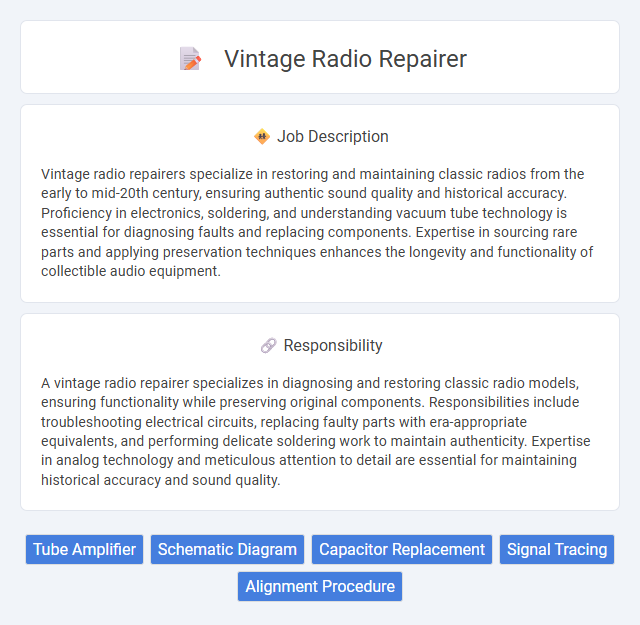
Vintage radio repairers specialize in restoring and maintaining classic radios from the early to mid-20th century, ensuring authentic sound quality and historical accuracy. Proficiency in electronics, soldering, and understanding vacuum tube technology is essential for diagnosing faults and replacing components. Expertise in sourcing rare parts and applying preservation techniques enhances the longevity and functionality of collectible audio equipment.
Individuals with strong attention to detail and patience are likely to be well-suited for vintage radio repairer roles, as the job requires delicate handling of intricate components. People who enjoy working with electronics and problem-solving in a hands-on environment probably find this work fulfilling. Those with limited manual dexterity or low tolerance for meticulous tasks might face challenges adapting to the precision needed in vintage radio restoration.
Qualification
A vintage radio repairer requires a solid understanding of electronic circuits, analog signal processing, and historical radio technology. Formal qualifications may include certifications in electronics, technical diplomas, or practical experience with vacuum tubes and classic audio components. Proficiency in using specialized testing equipment and the ability to source rare replacement parts are essential skills for effective restoration.
Responsibility
A vintage radio repairer specializes in diagnosing and restoring classic radio models, ensuring functionality while preserving original components. Responsibilities include troubleshooting electrical circuits, replacing faulty parts with era-appropriate equivalents, and performing delicate soldering work to maintain authenticity. Expertise in analog technology and meticulous attention to detail are essential for maintaining historical accuracy and sound quality.
Benefit
Vintage radio repairers likely enjoy the benefit of preserving historical technology while tapping into a niche market with potentially high demand among collectors and enthusiasts. Their specialized skills probably allow them to command premium fees for restoration work, contributing to financial stability. The job may also offer satisfaction from reviving unique, functional pieces with both aesthetic and sentimental value.
Challenge
Repairing vintage radios likely involves significant challenges due to the rarity of original parts and the delicate nature of aging components. The intricate circuitry may require specialized knowledge and precision to restore functionality without damaging the device. There is a high probability that troubleshooting these classic electronics demands patience and expertise to overcome the complexities inherent in obsolete technology.
Career Advancement
Specializing in vintage radio repair requires mastery of analog circuitry and historical electronics, which can lead to career advancement as a restored equipment expert or consultant for museums and collectors. Gaining certifications in electronics restoration and participating in workshops increases credibility and opens opportunities in specialty repair shops or educational roles. Building a reputation as a skilled vintage radio repairer can lead to leadership positions or launching a niche business specializing in antique audio equipment maintenance.
Key Terms
Tube Amplifier
Tube amplifier repairers specialize in restoring vintage radios by diagnosing and fixing issues related to vacuum tubes, capacitors, and transformers to preserve authentic sound quality. Expertise in soldering, circuit analysis, and sourcing rare replacement parts is essential to maintain original performance and prevent further damage. Skilled tube amplifier technicians ensure that classic radios operate safely and produce the warm, rich audio characteristic of vintage electronics.
Schematic Diagram
A vintage radio repairer relies heavily on mastering schematic diagrams to diagnose and restore classic radios accurately. These detailed circuit blueprints reveal the intricate connections and components, enabling precise troubleshooting and component replacement. Expertise in reading and interpreting schematic diagrams ensures the preservation of the radio's original sound quality and authentic functionality.
Capacitor Replacement
Capacitor replacement is a critical task for vintage radio repairers to restore optimal performance and prevent signal distortion caused by aged or leaking capacitors. Using high-quality, era-appropriate or modern equivalent capacitors ensures the preservation of authentic audio quality and extends the lifespan of radios. Accurate diagnosis and careful desoldering are essential to avoid damaging fragile circuit boards and maintain the vintage radio's original integrity.
Signal Tracing
Signal tracing in vintage radio repair involves systematically following the audio or radio frequency path to identify faulty components. Technicians use oscilloscopes, signal generators, and voltmeters to detect breaks, distortions, or weak signals within the circuitry. Mastery of signal tracing techniques ensures accurate diagnosis and restoration of classic radios to optimal working condition.
Alignment Procedure
The alignment procedure in vintage radio repair involves adjusting tuning circuits to restore optimal signal reception and audio clarity. Precision tools such as signal generators and oscilloscopes are used to calibrate intermediate frequency (IF) transformers and variable capacitors, ensuring the radio performs to original manufacturer specifications. Proper alignment enhances sensitivity, selectivity, and overall functionality, preserving the authenticity and longevity of the antique radio.
 kuljobs.com
kuljobs.com